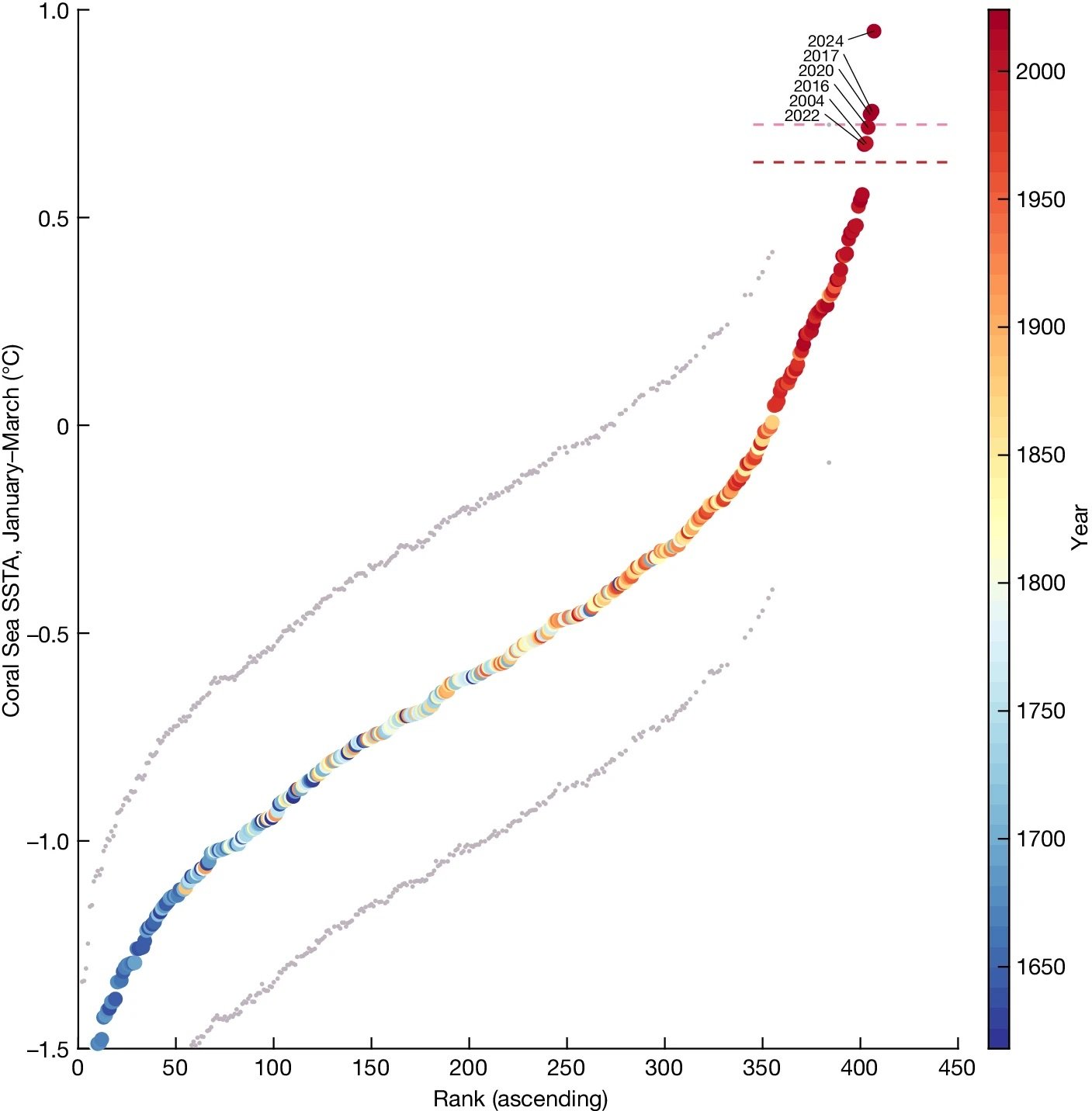Coupling Historical Proxy Data with Instrumental Records in the Great Barrier Reef Reveals Highest Ocean Heat in 400 Years | Henley et al. 2024
a–e, SSTAs (using ERSSTv5 data) for January–March in the Australasian region relative to the 1961–90 average for the five recent GBR mass coral bleaching years: 2016, 2017, 2020, 2022 and 2024. The black box shows the Coral Sea region (4° S–26° S, 142° E–174° E). f, Coral Sea and GBR mean SSTAs for 1900–2024 in January–March relative to the 1961–90 average. The black vertical lines indicate the five recent GBR mass coral bleaching years. Source: Henley et al. 2024
Ranked January–March SSTAs for 1618–2024 relative to 1961–90 (coloured circles) from the best-estimate (highest skill, full coral network) reconstruction (1618–1899) and instrumental (ERSSTv5) data (1900–2024). The year is indicated by the colour of the filled circles. The 5th–95th-percentile uncertainty bounds of the pre-1900 reconstructed SSTAs are shown by small grey dots. The year labels indicate the warmest six years on record, five of which were mass coral bleaching years on the GBR. The pink (upper) dashed line indicates the 95th-percentile uncertainty bound of the maximum pre-1900 reconstructed SSTA; the red (lower) dashed line indicates the 90th-percentile limit. Source: Henley et al. 2024
The recent paper by Henley et al. 2024 provides a comprehensive analysis of sea surface temperature (SST) anomalies in the Coral Sea over the past four centuries, highlighting the unprecedented ocean heat levels recorded in recent years. The study, widely featured across news headlines in August 2024, utilized a combination of instrumental SST observations and coral-derived temperature proxy data to reconstruct historical SSTs from 1618 to 1995. The findings reveal that the January - March Coral Sea heat extremes in 2024, 2017, and 2020 (in order of descending average SST anomalies) were the highest in the 400-year record, surpassing the 95th-percentile uncertainty limit of pre-1900 temperature reconstructions. The 2016, 2004 and 2022 events were the next warmest heat extremes, exceeding the 90th-percentile limit. The study underscores the critical threat these temperature extremes pose to the Great Barrier Reef, with mass coral bleaching events coinciding with the hottest years, indicating a severe risk to the reef's ecological integrity and biodiversity.
Long-term ocean observations such as the Australian Institute of Marine Science’s Long-Term Monitoring Program, are crucial to understand historical SST variations and allow us to distinguish between natural variability and anthropogenic changes, offering key insights to the accelerating trends of ocean warming and subsequent implications for marine ecosystems worldwide. This analysis links the recorded extreme ocean heat to anthropogenic climate change, as evidenced by climate model simulations that attribute the recent warming trends to human activities. Henley et al. 2024 emphasize the need for urgent intervention to prevent further degradation of this World Heritage Site, and the publication serves as a critical call to action for policymakers to implement more aggressive climate strategies to preserve one of Earth's most iconic natural wonders.


